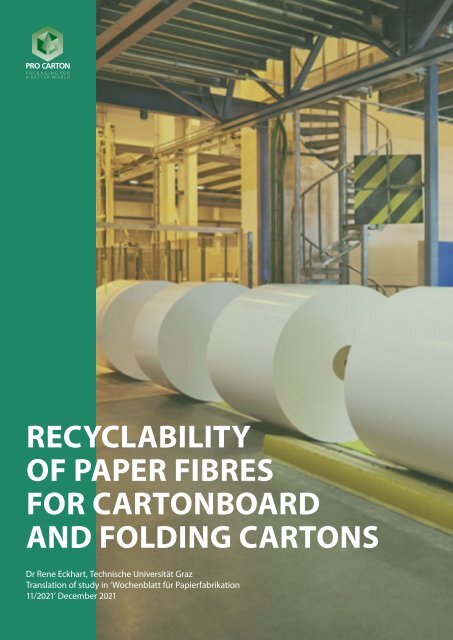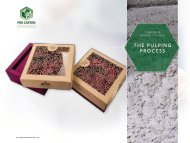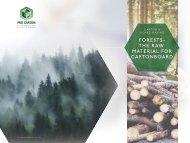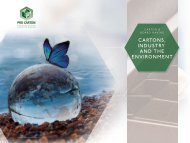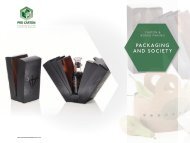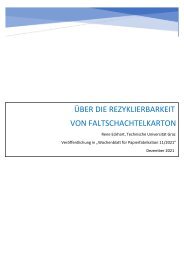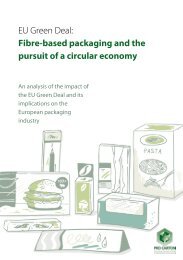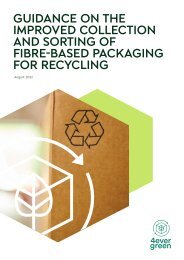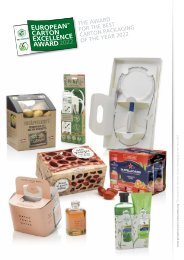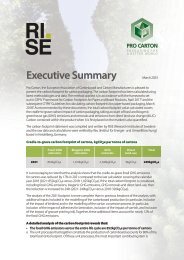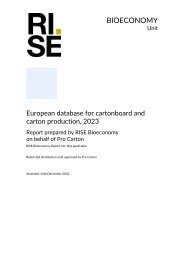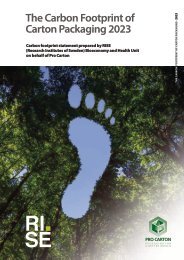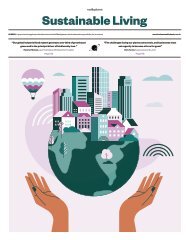Recyclability of Cartonboard and Cartons - English
You also want an ePaper? Increase the reach of your titles
YUMPU automatically turns print PDFs into web optimized ePapers that Google loves.
RECYCLABILITY<br />
OF PAPER FIBRES<br />
FOR CARTONBOARD<br />
AND FOLDING CARTONS<br />
Dr Rene Eckhart, Technische Universität Graz<br />
Translation <strong>of</strong> study in ‘Wochenblatt für Papierfabrikation<br />
11/2021’ December 2021
Introduction<br />
According to Eurostat, paper, board <strong>and</strong> cartonboard have by far the highest recycling rate <strong>of</strong><br />
all packaging materials, reaching around 85% in 2019. Metal comes in second at 81%, glass<br />
at 76%, with plastic at only about 40%. The European paper industry is even aiming to<br />
increase the recycling rate for fibre based packaging to 90% by 2030.<br />
Recovered paper, is the most important raw material for the production <strong>of</strong> paper, board <strong>and</strong><br />
cartonboard in Europe. Taking all types into consideration, its share is over 54%. Recovered<br />
paper is mainly used in newsprint <strong>and</strong> packaging materials such as corrugated base paper,<br />
folding boxes <strong>and</strong> packaging paper.<br />
While newspapers <strong>and</strong> corrugated board are produced from almost 100% recovered paper,<br />
the amount <strong>of</strong> recovered paper in folding boxes is significantly lower at around 35%. Due to<br />
product requirements <strong>and</strong> food regulations, the range <strong>of</strong> grades is divided into products that<br />
are largely produced from recovered paper (GT, GD cartonboard) <strong>and</strong> those based on virgin<br />
fibre (GC <strong>and</strong> GZ cartonboard).<br />
<strong>Cartonboard</strong> packaging is preferred by consumers because <strong>of</strong> its environmental credentials<br />
<strong>and</strong> its easy <strong>and</strong> well-established recyclability. The advantages <strong>of</strong> fibre-based packaging are<br />
seen in the use <strong>of</strong> renewable natural fibres, which are obtained from renewable raw materials<br />
from sustainable forestry <strong>and</strong> can be recovered from the waste stream after use.<br />
Recycling as much as possible has a significant positive effect on the eco-balance <strong>of</strong> the<br />
packaging, as it can reduce the specific water consumption in fibre production <strong>and</strong> also<br />
significantly reduces CO2 production thanks to the lower energy input. The more <strong>of</strong>ten the<br />
same item <strong>of</strong> packaging can be recycled, the more positive its impact on the environment.<br />
When it comes to producing GT/GD cartonboard based on recovered paper, mainly mixed<br />
recovered paper from household collections is used, with varying proportions <strong>of</strong> newspapers<br />
<strong>and</strong> magazines, <strong>and</strong> packaging materials such as corrugated board boxes <strong>and</strong> folding boxes.<br />
Decisive factors when selecting the different types <strong>of</strong> recovered paper include not only price,<br />
availability, <strong>and</strong> cleanliness, but above all the quality characteristics. While the properties <strong>of</strong><br />
folding cartons made <strong>of</strong> virgin fibre are very clearly defined by the grade classification, this is<br />
much more difficult when it comes to packaging made from recovered paper. It is no longer<br />
possible to determine whether the material used has ever been recycled or whether it has<br />
already passed through the recovered paper cycle many times. And depending on seasonal or<br />
local variations in the types <strong>of</strong> material collected, there are additional factors that influence<br />
the fibre mix.<br />
When using recovered paper for cartonboard packaging in general <strong>and</strong> specifically with the<br />
aim <strong>of</strong> increasing recovered paper collection rates, it is therefore important to underst<strong>and</strong><br />
whether <strong>and</strong> how the fibre properties change as a result <strong>of</strong> repeated recycling <strong>and</strong> how<br />
frequently recovered paper fibres are recycled in order to keep them suitable for cartonboard<br />
production.<br />
What we know already
In the paper industry <strong>and</strong> in numerous sources, many people persistently believe the myth<br />
that the maximum number <strong>of</strong> possible recycling cycles for paper fibres ranges between 4 <strong>and</strong><br />
7. A closer look at what has already been published on this issue shows that the number <strong>of</strong><br />
recycling cycles that can be carried out in a test setup is <strong>of</strong>ten less limited by the fibre or the<br />
quality <strong>of</strong> the fibre than it is by fibre losses that occur during the recycling process [1]. It is<br />
<strong>of</strong>ten difficult to compare the results since the boundary conditions (pre-dried/initially wet<br />
fibre, sheet formation, drying) are different every time. As far as the technological<br />
development <strong>of</strong> fibre is concerned, the key points are that fibre changes mainly in the first<br />
two to four recycling cycles in terms <strong>of</strong> water retention capacity <strong>and</strong> strength potential, while<br />
the additional changes are marginal. The current study by Putz <strong>and</strong> Schabel [2], on which this<br />
paper is largely based, also addresses this issue with a suitable setup for recycling. The study<br />
deals with a mixture <strong>of</strong> fibres <strong>of</strong> different ages as a starting material, which is based on the<br />
paper grade structure for the production <strong>of</strong> corrugated board in Germany (40% testliner 3,<br />
40% recycled fluting, 20% kraftliner), which corresponds to a mixture <strong>of</strong> 80% secondary<br />
fibres <strong>of</strong> different ages <strong>and</strong> 20% primary fibres. The defibration was carried out in an LC<br />
pulper with a material density <strong>of</strong> 4%. The h<strong>and</strong>sheet was prepared using white water<br />
circulation <strong>and</strong> sheets <strong>of</strong> 120 g/m² were produced. 25 cycles were performed <strong>and</strong> no primary<br />
fibres or minerals were added over these cycles. Over the 25 cycles, there was a decrease in<br />
water retention <strong>of</strong> 14.5%, a slight decrease in the grinding degree <strong>of</strong> 4 points, <strong>and</strong> a slight<br />
decrease in ash content, which is associated with unavoidable losses <strong>of</strong> fine materials during<br />
sheet formation. Losses in mechanical properties (breaking length, CMT, SCT etc.) over the<br />
25 cycles ranged from 5.1 to 11.6%. The reason cited for the low decrease is the low primary<br />
fibre content <strong>of</strong> 20%, since, as already mentioned, fibres undergo a change mainly in the first<br />
2-4 cycles. Based on this study, this paper examines the development <strong>of</strong> a fibre blend used for<br />
the production <strong>of</strong> white lined folding box board over 25 cycles. In contrast to the abovementioned<br />
study, the primary fibre content in this blend is somewhat lower <strong>and</strong> is represented<br />
exclusively by mechanically produced fibre, which according to Stürmer <strong>and</strong> Göttsching [3]<br />
loses hardly any strength potential during recycling. Moreover, the ash content in the blend<br />
used here is significantly higher at 21% than in the corrugated board mixture at 7.9%. On the<br />
one h<strong>and</strong>, the significantly lower primary fibre content leads to the expectation that the<br />
changes over the recycling cycles will be even smaller; on the other h<strong>and</strong>, it is necessary to<br />
take into account the high ash content in the test setup, as losses are to be expected during<br />
sheet formation which would subsequently distort the development <strong>of</strong> the technological<br />
properties.<br />
Carrying out the recycling study on folding box board<br />
The folding box board used in this study is constructed as follows:<br />
• Top liner: 30 g/m², white files <strong>and</strong> shavings<br />
• Underliner: 35 g/m², mixed recovered paper <strong>and</strong> packaging<br />
• Filler ply: 213 g/m², 75% mixed recovered paper <strong>and</strong> packaging, 25% RMP<br />
• Back ply: 40 g/m², 50% mixed recovered paper <strong>and</strong> corrugated board, 50% own waste
Uncoated unfinished cartonboard was used to make the experiment easier to carry out. For<br />
this reason, the primary fibre content represented by the refiner mechanical pulp (RMP) used<br />
in the filler ply is just under 18% (waste taken into account). The ash content is 21%, as<br />
already described above. This high ash content would make it impossible to interpret the<br />
development <strong>of</strong> the technological properties <strong>of</strong> the fibre, as the ongoing loss <strong>of</strong> ash during the<br />
course <strong>of</strong> repeated sheet formation would inevitably have a positive influence on the<br />
mechanical properties. This situation is taken into account during the study by largely<br />
removing the mineral components from the raw material in a laboratory pressure screen<br />
which is equipped with a perforated screen basket with a 250 µm hole diameter. Inevitably, a<br />
significant amount <strong>of</strong> the fine fibre material is also lost in this step. However, since the<br />
development <strong>of</strong> the fibre fraction is <strong>of</strong> primary interest in the study, this loss <strong>of</strong> fine material<br />
was consciously accepted <strong>and</strong> has no influence on the statements to be made. The ash content<br />
is reduced from 21% to 5.9% during this grading process, <strong>and</strong> the grinding degree is reduced<br />
from almost 40 SR° to 17 SR° due to the reduction in fibre fines. The mechanical properties<br />
are positively influenced by the reduction <strong>of</strong> mineral components that interfere with the fiberfiber<br />
bonding. The change in the length distribution <strong>of</strong> the fibre due to the grading is shown<br />
in Fig. 1 in the results section. Starting from this sorted raw material, 25 recycling cycles<br />
were simulated. The sheet formation was done on a Rapid-Köthen h<strong>and</strong>sheet formation with<br />
white water circulation. Any white water that goes towards the drain during sheet formation<br />
is collected <strong>and</strong> then used to suspend the sheets during recycling. In this way, virtually no<br />
fresh water was used over the recycling cycles, thus minimizing the loss <strong>of</strong> fibre material<br />
during sheet formation. Despite this, a certain loss <strong>of</strong> fibre material via the water ring vacuum<br />
pump is unavoidable. This amounts to an average <strong>of</strong> 0.98% per cycle over the cycles. A<br />
beater according to DIN EN ISO 5263-1 was used to redisperse the formed h<strong>and</strong>sheets.<br />
Redispersion was carried out for 25 minutes at a material density <strong>of</strong> 2%. Even though this<br />
laboratory disintegration can be described as gentle, it is known from the literature [4] that<br />
fine material is removed from the fibre surface during this process step. This manifested itself<br />
in an increase in the degree <strong>of</strong> grinding (in contrast to the study by Putz <strong>and</strong> Schabel [4] in<br />
which a decrease in the degree <strong>of</strong> grinding was recorded) over the 25 cycles. Grinding degree<br />
(EN ISO 5267-1), water retention (ISO 23714) <strong>and</strong> fibre morphology (ISO 16065-2) were<br />
determined after cycles 1, 3, 5, 7, 10, 15, 20, <strong>and</strong> 25. Sheet tests for thickness/density/volume<br />
(EN ISO 534), tensile strength (EN ISO 1924-2), bending stiffness (ISO 2493-1), <strong>and</strong> Scott<br />
Bond splitting work (ISO 16260) were carried out on every cycle up to cycle 10 <strong>and</strong> on every<br />
second cycle from cycle 10 onwards. In addition, the ash content (DIN 54370) was<br />
determined after cycles 1, 5, 12, <strong>and</strong> 25.<br />
Results <strong>of</strong> the recycling study on folding box board<br />
As already mentioned, the disintegration <strong>of</strong> the sheets in the laboratory beater during the<br />
recycling cycles leads to a production <strong>of</strong> fines, as fines are detached from the fibre wall. This<br />
can be seen both in the fibre morphology (Fig. 1) <strong>and</strong> in an increase in the degree <strong>of</strong> grinding<br />
(Fig. 2). The length-weighted fibre length distribution shown in Fig. 1 shows the effect <strong>of</strong> the<br />
grading <strong>of</strong> the raw material for the present study on the one h<strong>and</strong> <strong>and</strong> the development over<br />
the recycling cycles on the other.
Fig. 1: Length-weighted fibre length distribution <strong>of</strong> the raw material before grading (red),<br />
after grading, <strong>and</strong> after the individual recycling cycles. The detail shows the area <strong>of</strong> very fine<br />
material (200-400 µm).<br />
It is clearly evident that although recycling produces fine material (see also the detail in the<br />
diagram), there is essentially no change in the length distribution, i.e. no shortening <strong>of</strong> the<br />
fibre material. However, a large part <strong>of</strong> the fine material produced does not appear in this<br />
diagram, as only objects with a length <strong>of</strong> 200 µm or more are included in the length<br />
distribution. Similar effects can also be expected in the context <strong>of</strong> stock preparation on a<br />
production line. The extent <strong>of</strong> this will depend on the aggregates used, the process steps, <strong>and</strong><br />
the energy input. The increase in the grinding degree <strong>and</strong> the development <strong>of</strong> the water<br />
retention capacity can be seen in Fig. 2.
Fig. 2: Development <strong>of</strong> grinding degree <strong>and</strong> water retention capacity over the 25 recycling<br />
cycles.<br />
A decrease was to be expected for the development <strong>of</strong> the water retention capacity due to the<br />
hornification <strong>of</strong> the fibre after repeated drying. There is also a slight decrease in water<br />
retention value at the beginning (up to cycle 10), but this is followed by a slight increase<br />
again. Apparently, two effects overlap here. On the one h<strong>and</strong>, we have the increasing<br />
hornification, which was not to be expected to be very pronounced anyway for this fibre,<br />
which consists primarily <strong>of</strong> secondary fibres <strong>and</strong> a proportion <strong>of</strong> wood fibre, <strong>and</strong> on the other<br />
h<strong>and</strong>, we have the increase in the degree <strong>of</strong> grinding due to the production <strong>of</strong> fines, which in<br />
turn increases the water retention capacity <strong>of</strong> the fibre. This production <strong>of</strong> fines during<br />
recycling also affects the sheet density <strong>and</strong> tensile strength (Fig. 3) <strong>of</strong> the h<strong>and</strong>sheets. The<br />
increased content <strong>of</strong> fines causes compaction <strong>of</strong> the sheet, which increases the bonded area<br />
<strong>and</strong> subsequently also the tensile strength. At least at the beginning, the ash content may also<br />
have an influence, as it drops from an initial 5.8% to 3.8% by cycle 5. Over the additional<br />
cycles up to cycle 25, the ash content then remains constant, so that no further influence on<br />
the mechanical properties is to be expected. Other mechanical properties considered were the<br />
bending index relevant for this product group, as well as the Scott Bond splitting work (Fig.<br />
4). These two parameters show no significant development over the 25 cycles. Either the<br />
fibre is not affected at all by recycling with regard to these two properties, or the negative<br />
development <strong>of</strong> the fibre is more or less compensated for by the production <strong>of</strong> fines <strong>and</strong> the<br />
associated increase in binding capacity.<br />
Conclusion<br />
Unlike in the case <strong>of</strong> the study on the corrugated board mixture [4], in which a decline in the<br />
mechanical properties <strong>of</strong> between approx. 5 <strong>and</strong> 10% was recorded over the 25 cycles, no<br />
negative effect on the mechanical properties in question can be demonstrated in this study.<br />
The swelling capacity <strong>of</strong> the fibre (represented here by the water retention capacity) also<br />
shows no clear negative trend. A less pronounced effect was to be entirely expected for the<br />
present folding box board blend due to the lower primary fibre content, which was limited to<br />
refiner wood fibre. Especially in the case <strong>of</strong> the swelling capacity, but also in the case <strong>of</strong> the<br />
mechanical properties, it can be assumed that the effect <strong>of</strong> stock preparation (in the case <strong>of</strong><br />
this study, redispersion <strong>of</strong> the sheets in a laboratory beater for 25 minutes at a density <strong>of</strong> 2%)<br />
compensates for any negative effects <strong>of</strong> hornification. This influence <strong>of</strong> redispersion <strong>and</strong><br />
stock preparation will vary depending on the aggregates used, process steps, <strong>and</strong> energy<br />
input, <strong>and</strong> will naturally be reflected in the mechanical properties. In principle, however, it<br />
can be clearly stated on the basis <strong>of</strong> this study that the fibre itself allows recycling over 25<br />
cycles without further difficulty <strong>and</strong> that no limiting trend can be foreseen in this study.<br />
Therefore, limiting factors for the recycling <strong>of</strong> the fibre will primarily be unavoidable losses<br />
<strong>of</strong> fibre together with waste in the waste paper grading process, as well as the stress on the<br />
fibre in the preparation process, which leads to the production <strong>of</strong> fibre fines <strong>and</strong> possibly also<br />
to significant damage to the fibre. The results show that folding boxes represent a highly<br />
sustainable packaging solution that can seemingly be recycled any number <strong>of</strong> times <strong>and</strong><br />
whose number <strong>of</strong> recycling cycles is limited mainly due to the waste paper collection rate <strong>and</strong><br />
the losses that occur during cleaning <strong>of</strong> the fibre material.
Fig. 3: Development <strong>of</strong> the tensile index <strong>and</strong> the sheet density over the 25 recycling cycles.<br />
Fig. 4: Development <strong>of</strong> the bending index <strong>and</strong> the Scott Bond splitting work over the 25<br />
recycling cycles.
[1] Eriksson, I., Lunabba P., Petterson A., Carlsson G.; Recycling Potential <strong>of</strong><br />
thermomechanical fibres for newsprint; Tappi Journal, 80(1997), No. 7, p. 151 ff.<br />
[2] Putz H.J., Schabl S.; Der Mythos begrenzter Faserlebenszyklen; Wochenblatt für<br />
Papierfabrikation 6(2018), p. 350 ff.<br />
[3] Göttsching L., Stürmer L.; Physikalische Eigenschaften von Sekundärfaserst<strong>of</strong>fen unter<br />
dem Einfluss ihrer Vorgeschichte, Teil II: Einfluß des mehrfachen Recycling; Wochenblatt<br />
für Papierfabrikation, 106(1978) No. 23/24, p. 909 ff.<br />
[4] Heijnesson A., Simonson R., Westermark U.; Metal Ion Content <strong>of</strong> Material Removed<br />
from the Surface <strong>of</strong> Unbleached kraft Fibres; Holzforschung 49(1995), p. 75 ff


